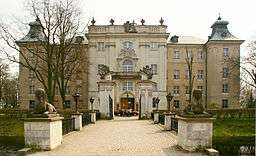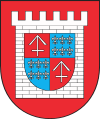Rydzyna
| Rydzyna | ||
|---|---|---|
| ||
 Rydzyna | ||
| Coordinates: 51°48′N 16°40′E / 51.800°N 16.667°E | ||
| Country |
| |
| Voivodeship | Greater Poland | |
| County | Leszno | |
| Gmina | Rydzyna | |
| Area | ||
| • Total | 2.17 km2 (0.84 sq mi) | |
| Population (2006) | ||
| • Total | 2,539 | |
| • Density | 1,200/km2 (3,000/sq mi) | |
| Postal code | 64-130 | |
| Website | http://www.rydzyna.pl | |
Rydzyna [rɨˈd͡zɨna] (German: Reisen) is a Polish town that was the seat of king Stanisław I during his first short reign from 1704 to 1709. Rydzyna is commonly referred to as "the pearl of the Polish baroque".

Rydzyna is situated in the southern part of the Wielkopolska Province, 10 km south of Leszno, in the Leszno county (powiat), on the main Poznań - Wrocław highway E5. The town's population is 2446 (2006). The population of the overall Rydzyna community is 8200.
History
It was founded at the beginning of the 15th century by Jan from Czernina, a descendant of the Wierzbno family, a knight of king Władysław II Jagiełło. At the end of the 17th century the town and its environs were owned by well-known magnates, the Leszczyński and then the Sułkowski families, whose investment in the town resulted in its current nickname as "the pearl of the Polish baroque".
Rydzyna Castle

The most historically important site in Rydzyna is Rydzyna Castle, formerly the residence of king Stanisław I and the Sułkowski princes. The castle in Rydzyna was built at the beginning of 15th century by Jan of Czernina. At the end of the 17th century, Italian architects Joseph Simon Bellotti and Pompeo Ferrari erected the present Baroque castle on its ancient foundations. The first owners of the castle were the Leszczyński family. Together with its park and surrounding areas, it was one of the most splendid palaces in Poland. Between 1704 and 1709 it was a residence of the Polish king Stanisław I. In 1709, during the Great Northern War, the castle was partly burnt by the tsar's soldiers. However wall-paintings and stucco works in representative rooms, made by the best Italian artists, were not destroyed completely, and the castle was restored and expanded by Prince August Sułkowski, who purchased the Leszczyński estates in 1738. The castle, together with its adjacent park and the surrounding terrain, forms one of the most valuable castle-park complexes in Poland.
Other historical sites
Other historical monuments within the town boundaries are baroque tenement houses around the market square together with the town hall and the baroque parish church, all built in the 18th century and designed by the same architects as the castle. The evangelical church building now serves as a concert hall. In the center of the market square a unique statue representing the Trinity was erected in 1761 by the sculptor Andrew Schmidt in memory of the plague that decimated the town in 1709. The monumental former annexes to the castle, facing its north side, are in Classic style. All the monuments are the works of prominent architects brought in from all over Europe by the Leszczyński and Sułkowski families.
At one time there were over 40 windmills around Rydzyna, Today only one remains, renovated in 2003 it now houses the Museum of Agriculture and Milling.
Notable residents
- Gustav Sorge (1911–1978), SS-guard at Esterwegen concentration camp
References
- Rydzyna town home page
- Sułkowski family
Coordinates: 51°47′N 16°39′E / 51.783°N 16.650°E
